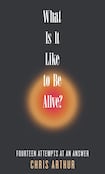
What Is It Like to Be Alive? is the ninth collection by Chris Arthur, the award-winning Belfast-born essayist. Life, understood here, is not just restricted to human life but includes animals and plants. By any reckoning, Arthur has set himself an ambitious task.
Throughout 14 essays, he attempts to address the question of the book’s title through astonishingly diverse ruminations. The opening essay, which centres on the plight of prostitutes in 17th-century Japan, may appear on the face of it to have virtually nothing in common with other essays on the extraordinarily slow growth of lichen on the wall of an Edinburgh flat, or the wondrous lives of goldcrests, or ageing and creativity. Yet common themes emerge as Arthur’s essays deepen the mystery of being alive. That question mark in the title is important: to read What is it like to be alive? is not to get better answers: it is to get better questions.
Those familiar with Arthur’s essays will recognise his method: typically, some trivial object, or an image that we might quickly pass over, or a fleeting event or sensation, will prompt a process of reflection that gradually opens out into ever-enlarging questions about the nature of the human experience.
An early essay prompted by the memory of a loose ferret trying to scurry through a cranky Welsh neighbour’s letter box transforms into a contemplation on how little we fail to recognise “the mystery sitting close at hand, right beside us, in the lives of those we see every day, but about whom we know almost nothing”.
The Enlightenment gave rise to a habit of worshipping ‘great men’, but they never had to worry about dying in childbirth
I may very well have ignored the call to home if I hadn’t been robbed at knifepoint in Brazil
Aer Dogs by Tom Lyons: Ryan family deserve credit for paradigm change in airline business
Fiction in translation: Swedish bestseller Colony an impressive study of community, secrets and trust
Such an observation might be considered banal left at that. But, for Arthur, commonplace events we barely register are vehicles for imagination: he thinks “about the possible tonnage of a moment”, such as the ferret’s attempted invasion, which further prompts him to think “vertically as well as horizontally”. As the horizon of speculation expands, we will discover that we are unable to grasp the totality of any moment: “everything that happens here on this particular patch of earth adds another incremental layer of presence, contributes to the platform of history-in-this-place on which every subsequent moment performs its pirouette of individual specificity”.
An essay on the statue of hero-or-villain British military leader John Nicholson, which stands in Lisburn, is a fascinating exercise in the politics of commemoration, the biases of reputation, and the public’s forgetting of history
Other objects of representation that we surround ourselves with but so often overlook, such as photographs, paintings and statues, can be equally revealing of the vast continuums of space and time in which we exist. In Transition is centred on an old school photograph (reproduced in the book) of a recently deceased classmate.
Elsewhere, A Lament for Tama and Picturing the Day also consider how paintings reveal life’s temporal, transitory nature. These essays not only explore the metaphysical tensions between change and constancy embedded with a visual image or statue, they also shrewdly examine themes such as the politics of representation and the subjective nature of our individual perceptions.
An essay on the statue of hero-or-villain British military leader John Nicholson, which stands in Lisburn, is a fascinating exercise in the politics of commemoration, the biases of reputation, and the public’s forgetting of history. While Arthur encourages wonder at “our utterly remarkable, endlessly transitioning selves” within the immensity of the cosmos, there is darkness here too. When he extrapolates larger meanings of the human experience from the encounter with other people, he is always deeply sensitive to the lives of individuals.
The harrowing Splinter recounts how a former history student of Arthur’s became so distressed by her research into the Holocaust that he advised her to stop. Unsure to this day if that was the right advice, the essay exemplifies Arthur’s brilliant capacity to meditate on the limits to inquiry as well as the moral imperative to “stare unflinchingly into the very heart of horror”.
The title of the book asks what it is “like” to be alive. Arthur explains use of the comparative – it is not just that total knowledge of life lies beyond the human scale or that language cannot adequately capture reality, it is that the human record is a register of people saying: “this is what life was like for me”. Appropriately, he draws liberally on other thinkers and artists to orientate his thoughts. We must, as his great essayist forebear Montaigne said, “allow our minds to rub up against others”. (Arthur says his favourite statue is of one of Montaigne, in Paris).
In lightly-touched reflections on his mortality, he is sanguine and not without humour; in following Montaigne’s example, Arthur’s essays are profound without ever being pompous. In a world where deceptively simple answers to deeply challenging questions are too quickly offered, it is a delight to read deeply challenging answers to a deceptively simple question.
- Eoghan Smith’s latest novel is A Mind of Winter (Dedalus Books)














